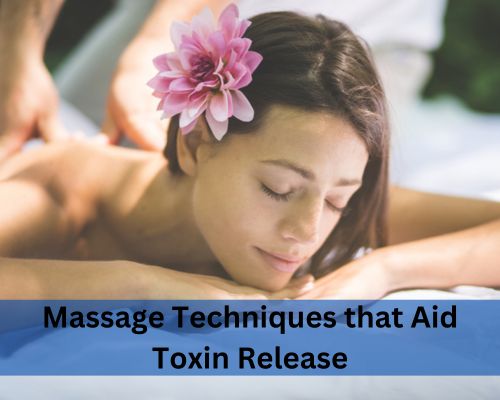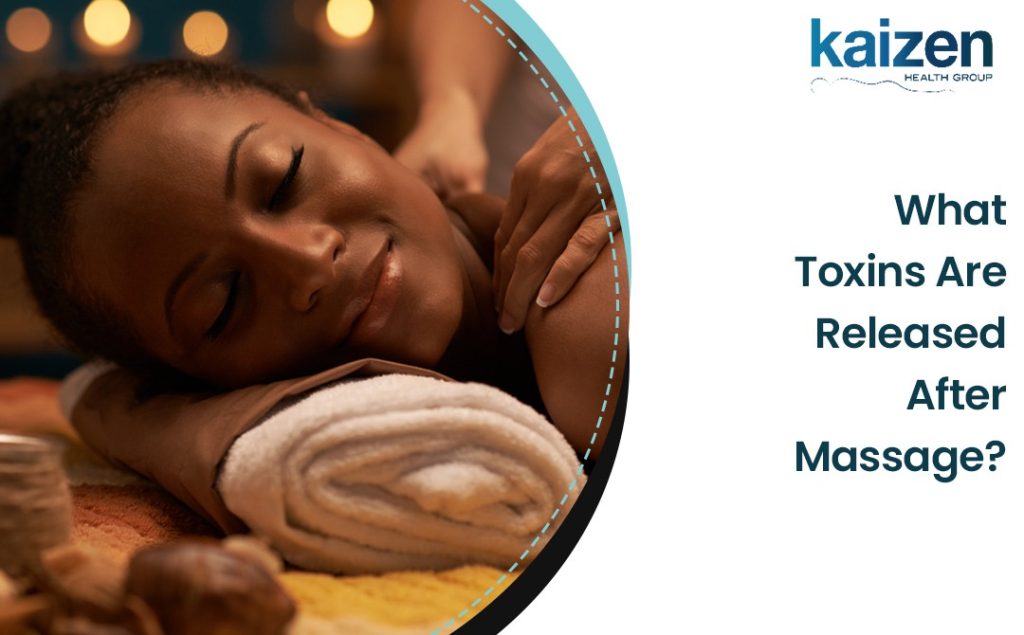Massage therapy is well known for relieving stress, but it also supports the body’s natural detox process. Depending on the technique, a massage can help release lactic acid, metabolic waste, and stimulate the lymphatic system to flush out toxins.
For example, deep tissue massage targets built-up waste in muscles, while Swedish massage boosts circulation and lymph flow. Not all massages affect the body the same way, and some techniques may not release toxins at all.
That’s why choosing a qualified massage therapist is essential. A trained professional understands how each technique influences the body’s systems.
What Toxins are Released During Massage?

Massage therapy supports the body’s natural detox pathways by enhancing circulation and stimulating lymphatic flow. Here are the key substances released and their benefits:
- Lactic Acid
This metabolic byproduct accumulates in overworked muscles and causes soreness. Massage breaks it down and moves it into the bloodstream for elimination, reducing post-exercise pain. - Stress Hormones (Cortisol & Adrenaline)
High cortisol levels contribute to stress, poor immunity, and fatigue. Studies show massage can significantly reduce cortisol (by ~30%) while boosting serotonin and dopamine for improved mood. - Histamines
These immune-related chemicals can drive inflammation and swelling. Massage may help balance histamine levels, easing fluid buildup and allergic responses. - Endorphins
Your body’s natural pain relievers light up after massage, promoting well-being and calm. - Metabolic Waste (e.g., Urea & CO₂)
By improving blood and lymphatic flow, massage helps mobilize and remove cellular waste products like urea and carbon dioxide.
Best Practices After Massage
- Hydrate: Water flushes out mobilized waste
- Rest Gently: Skip intense workouts immediately
- Add Lymphatic Work: Light movements amplify circulation benefits
- Try Contrast Therapy: Warmth plus massage further boosts flow
Book your massage at Kaizen Health Group today and start your detox journey!
Massage Techniques That Support Toxin Release
Certain massage techniques go beyond relaxation—they stimulate circulation, break down waste buildup, and assist the body’s natural detox process. Here are the most effective ones:
- Swedish Massage
This gentle, flowing technique uses long strokes, kneading, and circular motions. It improves circulation and stimulates the lymphatic system, helping flush out lactic acid and other metabolic waste. Ideal for overall relaxation and light detox. - Deep Tissue Massage
Targets deeper layers of muscle and connective tissue using firm pressure and slow strokes. It breaks down knots, releases built-up lactic acid, and enhances blood flow making it excellent for chronic tension and toxin elimination. - Hot Stone Massage
Heated stones are placed on key points to relax muscles and boost circulation. The warmth enhances blood flow and encourages waste release while delivering deep relaxation and nervous system balance. - Aromatherapy Massage
Combines massage with essential oils chosen for their detoxifying and calming properties. Oils are absorbed through the skin and inhaled, supporting both emotional well-being and physical toxin elimination. - Thai Massage
Incorporates acupressure, passive stretching, and deep compression. This dynamic technique boosts blood and lymph circulation, clears energy blockages, and encourages detox through movement and breath. - Sports Massage
Designed for athletes and active individuals, this technique focuses on muscle recovery. It helps release lactic acid, reduce soreness, and flush metabolic waste through targeted pressure and deep kneading.
Each technique offers unique benefits. Choosing the right one depends on your goals—relaxation, recovery, or deeper detox. For expert guidance and personalized sessions, book with a licensed therapist at Kaizen Health Group.

In conclusion, understanding the toxins released after a massage offers valuable insights into the incredible benefits of this therapeutic practice. From lactic acid to heavy metals, massages aid in flushing out harmful substances and promoting overall well-being.
Kaizen Health Group, a leading name in holistic wellness, recognizes the significance of massage therapy for toxin release. As toxins accumulate in our bodies due to various factors, massage therapy emerges as a powerful tool for detoxification.
Embracing regular massages and proper hydration and rest can optimize the body’s natural cleansing processes, leaving you feeling revitalized, rejuvenated, and ready to embrace a healthier, toxin-free life.
FAQ - Toxins Released after Massage
Many people believe it does, but research hasn’t confirmed this clearly. Deep tissue massage helps improve circulation, relax tight muscles, and ease physical tension, which supports your body’s natural healing process.
Muscle knots are tight spots in the muscle fibers that often form due to stress, overuse, or poor posture. These areas can feel sore or tender. Massage helps by loosening these fibers and restoring movement.
Massage encourages blood and lymph flow, which helps the body move waste products like lactic acid through natural detox pathways. This helps the body function better and feel more balanced.
Some people feel sore, tired, or lightheaded after a massage. This is usually a response to muscle release and improved circulation, not a sudden flood of toxins. Rest and hydration often help you recover quickly.
Massage relaxes the nervous system and muscles. This calm state can lead to a drop in energy levels. Feeling sleepy or slow afterward is a normal response.
Drinking water helps support the body’s efforts to remove waste. It also prevents dehydration, which can sometimes follow a deep massage session.
Yes, it can happen. As blood flow increases and tension leaves the body, some people may feel lightheaded or queasy. These sensations usually fade with rest and hydration.
You might feel tired, thirsty, slightly sore, or more emotional. Some people notice more frequent urination or a mild headache. These signs reflect the body adjusting and are usually short-lived.


